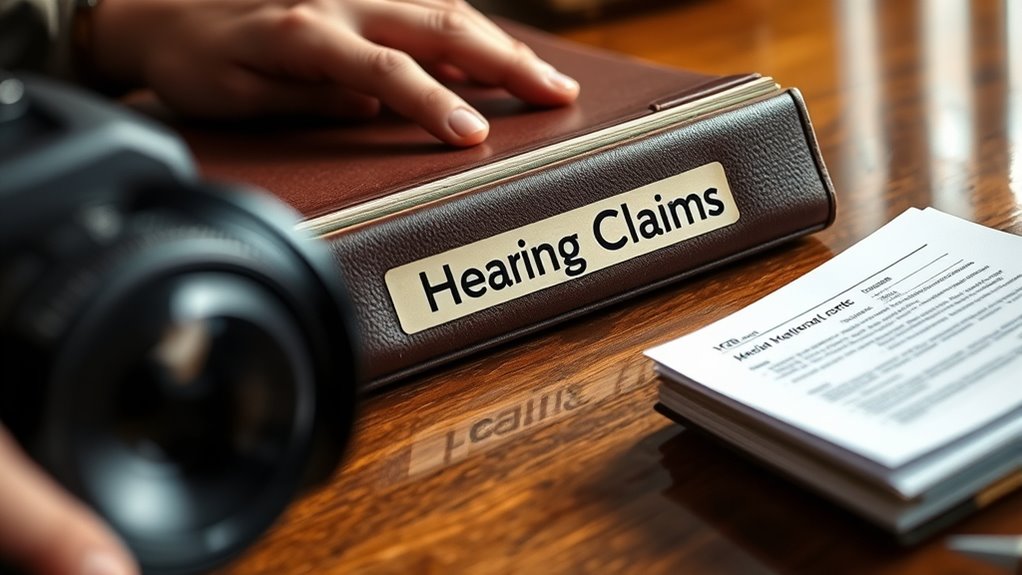To understand 38 CFR evidence standards for hearing claims, you should focus on how your evidence is evaluated for credibility, relevance, and reliability. The standards emphasize verifying medical records, confirming diagnoses, and ensuring consistency in your personal statements and third-party reports. Reputable sources and detailed documentation strengthen your case. By mastering these guidelines, you’ll improve your ability to gather strong evidence. Continuing to learn more can help you navigate the process even more confidently.
Key Takeaways
- The 38 CFR evidence standards ensure claims are based on reliable, relevant, and credible medical and service-related documentation.
- Verifying medical records confirms diagnoses, treatment history, and service events, strengthening claim credibility.
- Evidence must be consistent, corroborated, and from reputable sources to be deemed credible and reliable.
- Relevant evidence should directly relate to the hearing condition and demonstrate a clear service connection.
- Proper assessment of evidence’s weight and reliability aids in fair, consistent decision-making for hearing claims.

When steering the claims process for veterans’ benefits, understanding the 38 CFR evidence standards is crucial. These standards set the framework for how evidence is evaluated, ensuring that decisions are fair and based on reliable information. As you navigate this process, you’ll quickly learn that medical record verification plays a critical role in establishing the validity of your claim. The VA places significant emphasis on verifying medical records to confirm diagnoses, treatment history, and related service events. This verification process involves cross-checking documents, hospital records, and provider reports to ensure they accurately reflect your medical history. Accurate medical record verification helps establish a clear link between your current condition and your military service, which is indispensable for a successful claim. Additionally, the use of proper documentation techniques, such as medical record verification, enhances the credibility of the evidence you present.
In addition to verifying records, you’ll need to understand how credibility assessment factors into the evidence standards. The VA evaluates the credibility of all submitted evidence, including your personal statements, medical records, and third-party reports. They look for consistency, corroboration, and reliability when weighing the evidence. For example, if your medical records support your claim and align with your personal statements, your credibility is strengthened. Conversely, discrepancies or unsupported assertions may weaken your case. It’s crucial to provide honest, detailed accounts of your symptoms and how they relate to your service, as this can positively influence credibility assessments.
The 38 CFR standards also require that evidence be relevant and material to your claim. This means any medical records or statements you submit should directly relate to your hearing condition and its connection to your service. The VA may also consider the timing of records, ensuring they are recent enough to reflect your current health status. When submitting evidence, you should ensure all records are complete and thorough, as gaps can hinder the credibility assessment or lead to questions about the accuracy of your claim.
Finally, understanding that evidence must meet specific criteria for weight and reliability helps you prepare more effectively. Medical records verified through reputable sources carry more weight, and credible testimony can reinforce your case. By focusing on thorough medical record verification and presenting consistent, honest information, you strengthen your position under the 38 CFR standards. This awareness not only helps you gather the strongest possible evidence but also enables you to advocate confidently for your rightful benefits. Ultimately, mastering these standards allows you to navigate the claims process with clarity and increase your chances of a favorable outcome.
Frequently Asked Questions
How Do I Submit New Evidence for My Hearing Claim?
You should submit new evidence by officially mailing it to the VA or uploading it through the VA’s online portal. Make sure to clearly label your evidence submission for your hearing claim, and include your claim number. This allows for claim review and guarantees your new evidence is considered. Keep copies of everything you send, and follow up to confirm the VA received your submission before your hearing.
What Types of Evidence Are Most Persuasive Under 38 CFR Standards?
You might think all evidence is equal, but under 38 CFR standards, medical reports and expert opinions are the most persuasive. They provide credible, detailed insights into your condition that the VA highly values. To strengthen your claim, ensure these documents are recent, thorough, and clearly connect your disability to your service. Presenting strong, well-supported evidence can considerably improve your chances of a favorable decision.
Can I Submit Evidence After My Initial Claim Decision?
Yes, you can submit evidence after your initial claim decision, but you need to be aware of timing requirements and evidence deadlines. Generally, you should submit new evidence within one year of the decision to guarantee it’s considered. If you miss these deadlines, your evidence may only be reviewed if you request a reconsideration or appeal, so act promptly to include any supporting documentation.
Are Lay Statements Accepted as Evidence in Hearing Claims?
Yes, lay statements are accepted as evidence in hearing claims. You should focus on the credibility of the lay statements, ensuring they clearly describe your symptoms and their impact. Follow the evidence submission procedures carefully, submitting these statements along with other evidence to support your claim. Providing detailed and honest lay statements can considerably strengthen your case, demonstrating the real-life effects of your hearing condition.
How Does the VA Evaluate Medical Evidence Versus Lay Evidence?
The VA evaluates medical evidence, like medical documentation, based on its accuracy and relevance, often giving more weight to it. Lay testimony, such as personal statements, is considered valuable for describing symptoms or incidents but generally isn’t enough alone to establish a service connection. You should provide detailed medical documentation to support your claim, while your lay testimony helps clarify how your condition affects daily life.
Conclusion
By grasping the 38 CFR evidence standards, you hold the key to revealing your claim’s true potential. Think of these standards as a sturdy bridge guiding your case across turbulent waters to the calm shores of approval. When you navigate with clarity and confidence, you transform complex rules into stepping stones that lead you closer to justice. Remember, understanding these standards is like wielding a lantern in the dark—illuminating your path to victory.











